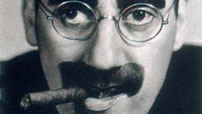Kategori: In English
-

After Hours on the Miracle Mile: The Logic of Nightmares in Film
FEATURE. Film critics frequently relate After Hours (1985) and Miracle Mile (1989) to nightmares. But what is it about them that evokes an impression of the nightmarish? Drawing on cognitive studies of film, Katherine Spring first explains how the two films facilitate spectarial alignment and empathy before analyzing how their narrative designs elicit affective states that resemble those we experience in nightmares.
-

Given Circumstances: The East Asian Cinema of Akira Kurosawa, Part 2
FEATURE. In issue no. 22 Bert Cardullo discussed the career and working methods of Akira Kurosawa and rebutted claims about Kurosawa being a particularly ”Western” director. In the present article Cardullo develops his argument in a closer analysis of The Seven Sumarai.
-

Given Circumstances: The East Asian Cinema of Akira Kurosawa, Part 1
FEATURE. Bert Cardullo has collected a number of interviews with Akira Kurosawa that are to be published by University Press of Mississippi in 2008. To mark that occassion, and as a supplement to the book, Cardullo will be discussing the cinema of Kurosawa in two essays of which this is the first.
-

The “Wondrous Truth” of Microcosmos
FEATURE. Claude Nuridsany’s and Marie Perennou’s film about insect life, Microcosmos (1996), is a beautiful anomaly. It bears a resemblance to nature documentaries but also to poetic documentaries. It is a highly stylized film yet retains a strong connection to the real world. It has no overarching narrative yet contains fictionalized mini-narratives. Billy Budd Vermillion discusses the many paradoxes and ‘fuzzy boundaries’ of the film.
-

The Original Function of Groucho Marx’s Resignation Joke
FEATURE. Certain comic one-liners have become so legendary that they have been absorped into the collective pool of references that we tap into on a daily basis. Many will know the famous “Resignation Joke” attributed to Groucho Marx: “I don’t want to belong to any club that will accept me as a member.”? Some will also remember that Woody Allen revived the joke in the opening scene of Annie Hall (1977). Yet what was the original context and function of the joke? Richard Raskin fills us in.
-

The Sound of Sentiment: Popular Music, Film, and Emotion
FEATURE. In what ways does the song-based collage score differ from the instrumental classical score when it comes to expressing emotions and arousing them in spectators? This is the key question addressed by Murray Smith in this issue of 16:9. With particular emphasis on Trainspotting Smith explores the performative and lyrical dimensions distinctive of the song-based score yet also locates continuities between the emotional functions of classical and popular music.
-

On Reflection: Mirror and Me
FEATURE. Film director Andrzej Zulawski once remarked that one should never revisit films that one cannot tame. In this essay, Maximilian Le Cain does just that. In reassessing Andrei Tarkovsky’s Zerkalo/The Mirror (1974) and untangling it from the personal contexts in which he previously viewed the film, Le Cain explicates the ‘uncontainable’ nature of a film where a gust of wind is organically tied to the subjective world of the characters.
-

The Artist and the Killer: Fritz Lang’s Cinema of the Hand
FEATURE. Alfred Hitchcock once told Francois Truffaut that he thought the hands to be much more revealing of a character’s emotions than facial expression. This fascinating essay by Joe McElhaney on the cinematic use of the hand is in this line of thought but McElhaney reveals a vastly more elaborate and intricate use in the films of Fritz Lang.
-

Impressions of Violence, Moments of Witness: Style in the Assassination Scenes of Takeshi Kitano’s Sonatine
FEATURE. Stewart Heinz Fyfe takes a close look at the two assassination scenes in Sonatine (1993) and finds that they demonstrate both characteristic aspects of Kitano’s approach to the staging of violence, and the flexibility and utility of that approach in Kitano’s construction of cinematic narrative.
-

A Larry Clark Portrait
FEATURE. Adrian Martin explicates the work of a termite artist whose portraiture of characters ‘under the influence’ evokes a mood that is both discomforting and kinky, yet never dispassionate.
-

Up Close and Impersonal: Hal Hartley and the Persistence of Tradition
FEATURE. The enduring influence of a classical style, the fruitfulness of a comparative method and the need to make sense of contemporary cinema – these three precepts form the basis of David Bordwell’s article on Hal Hartley’s Simple Men. In the article, Bordwell demonstrates how an analysis sensitive to filmic traditions sheds light on formal changes and continuities in contemporary cinema. A Danish translation of the article was published in 16:9, no. 7.
-

Shadowplays: Tod Browning’s ‘Dracula’ and Karl Freund’s ‘The Mummy’
FEATURE. Maximilian Le Cain unearths stylistic idiosyncracies and conflicting narratives in two early horror classics from Universal Pictures.
